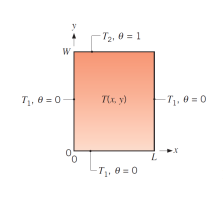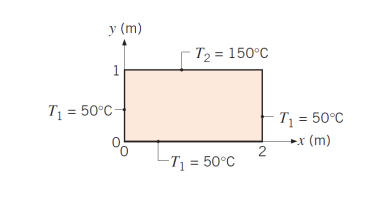logistic_guy
Junior Member
- Joined
- Apr 17, 2024
- Messages
- 209
here is the question
Derive the solution of the two dimensional steady-state heat diffusion equation using the method of separation of variables with the boundary conditions in figure 1.16. Use this solution to find the temperature at the midpoint \(\displaystyle T(1,0.5)\) with the boundary temperatures in figure 1.17. Show that the temperature at the midpoint is \(\displaystyle 94.5^{\circ}C\) by considering the first five nonzero terms of the infinite series that must be evaluated.
Hint: Use the transformation \(\displaystyle \theta \equiv \frac{T - T_1}{T_2 - T_1}\) and solve \(\displaystyle \frac{\partial^2 \theta}{\partial x^2} + \frac{\partial^2 \theta}{\partial y^2} = 0.\)
figure 1.16

figure 1.17

my attemb
this is the solution i must get

i think they want me to use the first part
\(\displaystyle \theta(x,y) = \frac{2}{\pi}\sum_{n=1}^{\infty}\frac{(-1)^{n+1} + 1}{n}\)
which look like infinite series of calculus
Derive the solution of the two dimensional steady-state heat diffusion equation using the method of separation of variables with the boundary conditions in figure 1.16. Use this solution to find the temperature at the midpoint \(\displaystyle T(1,0.5)\) with the boundary temperatures in figure 1.17. Show that the temperature at the midpoint is \(\displaystyle 94.5^{\circ}C\) by considering the first five nonzero terms of the infinite series that must be evaluated.
Hint: Use the transformation \(\displaystyle \theta \equiv \frac{T - T_1}{T_2 - T_1}\) and solve \(\displaystyle \frac{\partial^2 \theta}{\partial x^2} + \frac{\partial^2 \theta}{\partial y^2} = 0.\)
figure 1.16

figure 1.17

my attemb
this is the solution i must get

i think they want me to use the first part
\(\displaystyle \theta(x,y) = \frac{2}{\pi}\sum_{n=1}^{\infty}\frac{(-1)^{n+1} + 1}{n}\)
which look like infinite series of calculus
Last edited:
